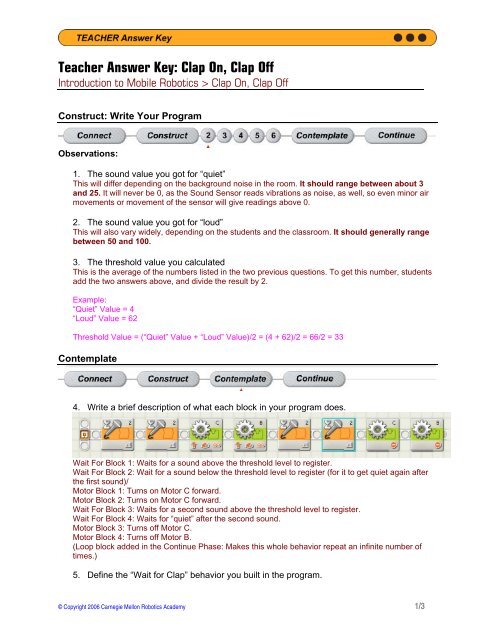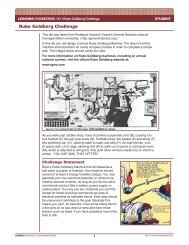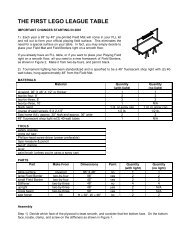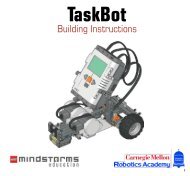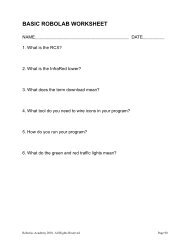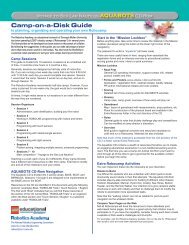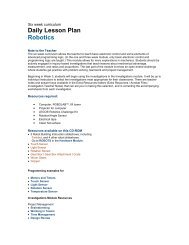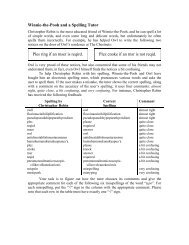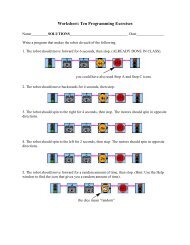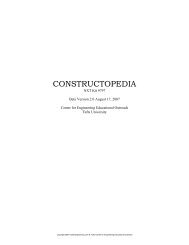Teacher Answer Key: Clap On, Clap Off - Robotics Academy
Teacher Answer Key: Clap On, Clap Off - Robotics Academy
Teacher Answer Key: Clap On, Clap Off - Robotics Academy
You also want an ePaper? Increase the reach of your titles
YUMPU automatically turns print PDFs into web optimized ePapers that Google loves.
<strong>Teacher</strong> <strong>Answer</strong> <strong>Key</strong>: <strong>Clap</strong> <strong>On</strong>, <strong>Clap</strong> <strong>Off</strong><br />
Introduction to Mobile <strong>Robotics</strong> > <strong>Clap</strong> <strong>On</strong>, <strong>Clap</strong> <strong>Off</strong><br />
Construct: Write Your Program<br />
Observations:<br />
1. The sound value you got for “quiet”<br />
This will differ depending on the background noise in the room. It should range between about 3<br />
and 25. It will never be 0, as the Sound Sensor reads vibrations as noise, as well, so even minor air<br />
movements or movement of the sensor will give readings above 0.<br />
2. The sound value you got for “loud”<br />
This will also vary widely, depending on the students and the classroom. It should generally range<br />
between 50 and 100.<br />
3. The threshold value you calculated<br />
This is the average of the numbers listed in the two previous questions. To get this number, students<br />
add the two answers above, and divide the result by 2.<br />
Example:<br />
“Quiet” Value = 4<br />
“Loud” Value = 62<br />
Threshold Value = (“Quiet” Value + “Loud” Value)/2 = (4 + 62)/2 = 66/2 = 33<br />
Contemplate<br />
4. Write a brief description of what each block in your program does.<br />
Wait For Block 1: Waits for a sound above the threshold level to register.<br />
Wait For Block 2: Wait for a sound below the threshold level to register (for it to get quiet again after<br />
the first sound)/<br />
Motor Block 1: Turns on Motor C forward.<br />
Motor Block 2: Turns on Motor C forward.<br />
Wait For Block 3: Waits for a second sound above the threshold level to register.<br />
Wait For Block 4: Waits for “quiet” after the second sound.<br />
Motor Block 3: Turns off Motor C.<br />
Motor Block 4: Turns off Motor B.<br />
(Loop block added in the Continue Phase: Makes this whole behavior repeat an infinite number of<br />
times.)<br />
5. Define the “Wait for <strong>Clap</strong>” behavior you built in the program.<br />
© Copyright 2006 Carnegie Mellon <strong>Robotics</strong> <strong>Academy</strong> 1/3
i. What are the two blocks that make up the behavior?<br />
The “Wait For <strong>Clap</strong>” behavior uses a Sound Sensor to wait for a single sound louder than the<br />
threshold level. It is made up of two blocks: one that waits for it to get loud, and one that waits<br />
for it to get soft (so you know the loud part has ended).<br />
ii. Why isn’t a single Wait For Sound block good enough?<br />
If you didn’t wait for it to get soft using the second Wait For block, then you would never know<br />
whether or not the loud sound had ended. Therefore, you wouldn’t know if it was a clap, or a long,<br />
extended scream, which might lead you to count the same sound twice. This way you can<br />
differentiate one loud sound from the next one, no matter what the sound duration.<br />
6. What does the threshold for the sound sensor do? What would happen if you set the<br />
threshold higher? Lower?<br />
The threshold for the Sound Sensor lets the sensor know what is “loud” and what is “quiet.” If<br />
the threshold were lower, then even softer sounds would be considered “loud.” If it were higher, then<br />
it would take a really, really loud sound for the sensor to recognize it as “loud.”<br />
7. Why did you use a value from the sound sensor that was halfway between silence and<br />
clapping for your threshold value?<br />
Students may have many different answers for this question.<br />
The halfway point is a good number to use because then loud sounds don’t always have to hit the<br />
same number (or above) to be considered “loud.” If “quiet” is always within the same range of<br />
numbers, then anything above that range could be considered “loud,” which is how the halfway point<br />
separates the values.<br />
The halfway point also adds a little bit of leeway above the typical “quiet” range to account for other<br />
stray sounds that you don’t want the Sound Sensor to recognize.<br />
It is also a good point to use because it is easy to calculate, and you can calculate it the same way<br />
every time.<br />
8. Does your robot respond only to claps, or do other sounds trigger the starting and<br />
stopping as well? Why do you think this is?<br />
Any loud sound will trigger the Sound Sensor. It can’t tell the difference between claps and other<br />
loud sounds, it just hears them all as “loud.” Interestingly, it will also respond if you were to tap the<br />
Sound Sensor, because it would “hear” the sound of your finger hitting the casing. It is also triggered<br />
if you were to blow on the Sound Sensor, because it would “hear” the vibrations from the air.<br />
9. Marisa is using the robot as an actor in a class play. She wants the robot to start running<br />
across the stage on cue. The cue will be the sound of a door slamming as another<br />
(human) actor goes off stage.<br />
i. How should she go about programming her robot to recognize the correct sound<br />
and begin its performance at the right time? Be specific.<br />
Depending on how specific the student is being, the answer might go something like this:<br />
Marisa would first need to get sound level from the stage area, so she knew what to set her<br />
threshold to. She would take sound readings during a typical play, and then slam the door on<br />
the stage and take sound readings of that. From these sound readings, she can calculate the<br />
threshold level for the sensor. Then she would program it.<br />
The robot should wait for loud, then wait for quiet again (which would be it waiting for the<br />
sound of the door slamming), and then should be programmed to go forward however far<br />
Marisa wants it to, and then stop. This behavior should not repeat in a loop.<br />
© Copyright 2006 Carnegie Mellon <strong>Robotics</strong> <strong>Academy</strong> 2/3
ii. What possible problems might there be with this plan?<br />
Other sound would be the biggest problem, because the robot would respond to other loud<br />
sounds, as well. For example, if the human performer was slamming the door in anger, then<br />
he/she was probably yelling before going offstage. This yelling might trigger the robot<br />
prematurely. Or, if the performance was particularly good, the audience might start clapping,<br />
which would also trigger the robot, possibly causing it to go at a time when it wasn’t wanted.<br />
10. The cafeteria staff at LeGou Middle School keeps order in the lunchroom by turning off<br />
the lights whenever the room gets too noisy. They’re tired of having to sit by the light<br />
switch the whole period though, and have heard that a robot may be able to help them<br />
out. Explain briefly how a sound sensor-equipped robot might be able to simplify or<br />
automate this task for them.<br />
Simply put, the robot can use its sound sensor to wait for the noise level in the room to get above a<br />
certain level (threshold). It can alert the staff when this happens by beeping, so that they can go over and<br />
turn off the light manually. In a more advanced robot, when this happens, a robotic arm could switch off<br />
the lights, so that staff wouldn’t have to do anything. In another application, the entire light switch could be<br />
robotic, with the sound sensor built in, so that when the sensor has been triggered, the switch can turn<br />
itself off, no robotic arm needed. Then the robot could wait for it to get quiet again, and use the robotic<br />
arm or switch backwards to turn the lights back on. If these behaviors were put in a loop, the robot could<br />
do this an infinite number of times every lunch period. The only problem is, the students may not “listen”<br />
to the robot, and a staff member may have to be on hand to quiet them down anyway.<br />
Continue<br />
<strong>Answer</strong> the following:<br />
11. How did the loop change the robot’s behavior?<br />
The loop didn’t change the robot’s behavior; it just made the behavior repeat.<br />
12. How many times will the loop run?<br />
The loop will run an infinite number of times, because that is the default configuration (you can check<br />
the setting in the configuration panel).<br />
Note: <strong>Answer</strong> <strong>Key</strong> and <strong>Teacher</strong> Notes for the Continue Activity “Frequency and<br />
Amplitude” can be found separately in the “Frequency and Amplitude <strong>Teacher</strong><br />
Notes” document.<br />
© Copyright 2006 Carnegie Mellon <strong>Robotics</strong> <strong>Academy</strong> 3/3


